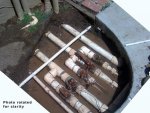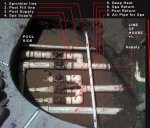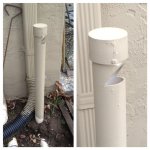One of my valves is leaking pretty badly from the stem so I think it is time to change out the entire valve assembly. These are in-ground valves for an in-ground pool and spa. THere is also a "deep heat" valve that my local swimming pool company suggested I just cap.
See my photos and I have tried to annotate what you are looking at. I was hoping to use 3-way valves and mount them up against the house, next to this planter. There is a single supply line that feeds this assembly. The pipes are 2" dia. The smaller pvc pipes are sprinkler piping and the fill line for the pool.
My question is given the design of the 3-way valves, will this be a clean looking assembly once brought up out of the ground? This is in plain view of the entire yard and behind a fence by my equipment so I want it to look decent. I am a little confused if the valves would be parallel or perpendicular to how they run now. I was hoping perpendicular so they could be assembled rather tight to the house. However, with two openings in each direction and then one at a 90º I am not sure how this would work. I assume having them above ground is superior (and easier to plumb, maintain, and use).
Are Jandy valves the best valves to use? My other option would be to try and just replace these one for one and keep them in-ground although the assembly is very tight and doing an "in-line" repair is tough unless slip connectors are available (speaking from sprinkler repair experience only).
Can anyone help me understand:
1) What the assembly would look like and how the valves would be oriented and plumbed? If you can point me to some pics or online resources it'd be great (or images of your own).
2) How hard of a job this is? The pool contractor wanted $600!
3) Specifically what valves I should use.
4) Do I have to do anything special before cutting the pipes? I am not sure how I would cap or do I have to?
I hope I have explained this good enough but if you need clarification please let me know. I would be indebeted to anyone that can help. I am pretty handy so I was hoping to do this myself but let me know if this is something I should not tackle! My brother in law works for a pump company that supplies farmers so I have his knowledge and experience available but this is slightly different.
Thanks in advance,
-Gary
See my photos and I have tried to annotate what you are looking at. I was hoping to use 3-way valves and mount them up against the house, next to this planter. There is a single supply line that feeds this assembly. The pipes are 2" dia. The smaller pvc pipes are sprinkler piping and the fill line for the pool.
My question is given the design of the 3-way valves, will this be a clean looking assembly once brought up out of the ground? This is in plain view of the entire yard and behind a fence by my equipment so I want it to look decent. I am a little confused if the valves would be parallel or perpendicular to how they run now. I was hoping perpendicular so they could be assembled rather tight to the house. However, with two openings in each direction and then one at a 90º I am not sure how this would work. I assume having them above ground is superior (and easier to plumb, maintain, and use).
Are Jandy valves the best valves to use? My other option would be to try and just replace these one for one and keep them in-ground although the assembly is very tight and doing an "in-line" repair is tough unless slip connectors are available (speaking from sprinkler repair experience only).
Can anyone help me understand:
1) What the assembly would look like and how the valves would be oriented and plumbed? If you can point me to some pics or online resources it'd be great (or images of your own).
2) How hard of a job this is? The pool contractor wanted $600!
3) Specifically what valves I should use.
4) Do I have to do anything special before cutting the pipes? I am not sure how I would cap or do I have to?
I hope I have explained this good enough but if you need clarification please let me know. I would be indebeted to anyone that can help. I am pretty handy so I was hoping to do this myself but let me know if this is something I should not tackle! My brother in law works for a pump company that supplies farmers so I have his knowledge and experience available but this is slightly different.
Thanks in advance,
-Gary




